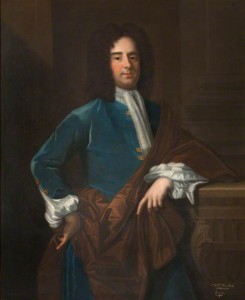
Reproduced by kind permission of the National Trust, Wallington Hall
The third William Blackett was of a very different character to that of his commercially astute father and grandfather who had established the vast and lucrative Blackett lead and coal business, bought landed estates in Northumberland and the ancient family seat of Woodcroft in Durham. According to most accounts the third William lived up to the stereotype of the dissolute third generation, fond of riotous living and spending well beyond his means, considerable as they were. However, in the absence of much primary material concerning the management of the business during this period, a degree of scepticism is possibly called for, especially as some of those third party accounts might have been influenced by William’s alleged dalliance with Jacobitism immediately before the 1715 rebellion -either because he was seen as suspect by loyalists, or as weak-willed by the rebels.
He inherited at the age of just 15. The business was in the hands of his father’s trustees, William Davison and John Wilkinson, and his father William II was not entirely free of debt himself. Members of the Allgood family, and John Ord, a sharp Newcastle lawyer also took a close interest in ‘serving’ young William Blackett over the following years, perhaps with their own opportunistic interests also in mind. The long late 17th century boom in the lead industry itself gave way to a deep depression in the years after 1705, possibly severe enough to have exhausted the resources of the strongest of businesses. Certainly the business was heavily encumbered by debt by the time of his death in 1728, a significant portion of which dated back to his father’s day. Much has been made of the £77,000 owed to Guy’s Hospital from the mid 1720s, but this was in fact a rational consolidation of previous loans as it reduced the interest bill. Nevertheless is was a dubious inheritance for William’s cousin, Walter Calverley, who was also required to marry William’s illegitimate daughter Elizabeth Ord within a year.
Greg Finch
See also:
E. Cruikshanks, ‘BLACKETT, Sir William, 2nd Bt. (1690-1728), of Pilgrim St., Newcastle-upon-Tyne, and Wallington Hall, Northumb.’ History of Parliament Online
R. Welford, Men of Mark ‘Twixt Tyne and Tweed, (1895), Vol 1
I.Forbes, ‘Elizabeth Ord: a woman in the 18th century’, Hexham Historian, 28, (2018), pp. 3-18
E.T.Hughes, North Country Life in the Eighteenth Century (1952)
L.Gooch, The Desperate Faction? The Jacobites of North-East England 1688-1745, (2001)
A.Purdue, The Ship That Came Home, (2004)
A.Kirtley, P. Longbottom & M. Blackett, A History of the Blacketts (2013)
G.Finch, The Blacketts, a Northern Dynasty’s Rise, Crisis and Redemption, (2021)

